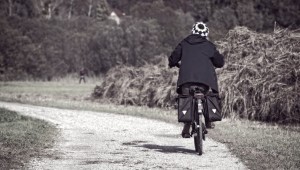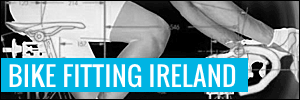If you’ve ever thought you would love to take up cycling or do a Cycling Sportive event, but feel you can’t, the good news is that according to recent studies, it’s never too late in life to start cycling or improving your level of fitness. Two and a half hours spread over a week of any exercise that raises the heart rate is all that is required to bring about substantial benefits and probably change your future health for the better. That’s little more than 20 minutes a day. This is true for any age. Regular physical activity reduces the risk of developing obesity, heart disease, diabetes and high blood pressure. It even helps to lower blood pressure in cases where it is already raised. High blood pressure is one of the leading causes of strokes and heart attacks in the world. There is also recent evidence to show that regular exercise has benefits for mental health, combatting depression and anxiety.

Gordon Brennan is the manager of Cycleways bike store in Dublin and he has also noticed a trend. “One thing is for sure,” he says, “there is no age limit for cycling. Literally yesterday I sold a bike to an 80 year old man who hasn’t owned a bike for many years who is adamant that he doesn’t want, in his own words, to ‘seize up’ in his later years.”
Who hasn’t joined the gym in January, only to lose the motivation sometime in March, if not before? Because it is also a form of transport, cycling is one of the best and easiest ways to incorporate exercise into your daily routine, and you don’t even have to dress in figure hugging Lycra. You can pedal at your own pace, going faster or slower depending on your ability and inclination. Just by cycling down to the shops every day to pick up the paper or post a letter, you would be getting fitter, burning calories and maybe even meeting the neighbours, instead of waving at them through a car window. If you live in a town or city with traffic congestion, the journey might even be quicker on a bike, while you at the same time are saving money on petrol and reducing your impact on the environment.
As we get older, we all develop the usual niggling problems: sore back, stiff knees, creaking joints and so on, but because cycling in particular is a low impact activity that puts very little pressure the joints, it is an ideal way to increase the amount of physical exercise you do. Riding a bike regularly may even be of benefit for painful joints. The Royal Bournemouth Hospital in Britain is running a trial where patients with joint pain are given 30 minutes exercise a day on a bicycle, as doctors there believe regular cycling could delay or prevent the onset of arthritis. Improved muscle tone and co-ordination are benefits also associated with regular cycling.
Gordon Brennan says of his customers, “Many are commenting how wonderfully social cycling is and also that it can be enjoyed on your own if that is your preference.” Whether it is just greeting those you meet en route to the local shop or whether you join a cycling group, the social aspect of cycling is important for a lot of people. In County Laois, the Durrow High Nelly club, set up in 2011 by local publican Bob Campion, now has over 60 members. The aim of the club is to provide an opportunity for fitness and a healthier lifestyle for its members. The club organises leisurely cycles every week while at the same time raising funds for local charities, such as the local Meals on Wheels group. More High Nelly clubs have since started up around the country.
For those looking to join a cycling group, there are clubs and more informal gatherings in every corner of the country. Virtually every weekend sees an organised cycling event taking place somewhere. The Cycle Series formerly sponsored by An Post and now known an the Sports Ireland cycle series includes five events each year with distances ranging from 10 to 160 kilometres and in 2012 over fifteen and a half thousand people of all ages took part. Signing up for such rides is a great way to keep motivated and set achievable goals.

One of the biggest fears expressed by participants in a recent study into older people’s experience of cycling was the fear of traffic. Indeed this fear stops many people from taking up cycling, but there is a lot you can do to keep yourself safe. If you are rescuing an old bone-shaker from the shed, get it serviced and checked by someone who knows what they are doing. At night, light it up like a Christmas tree. Observe the rules of the road at all times. When you are in traffic, assume you are invisible to other road users and cycle accordingly. A helmet, while not legally required, is an essential piece of kit which could save your life.
If you are nervous, ride your bike on quiet roads or in parks until you gain a little more confidence. Cycle lanes can also be a confidence booster for those nervous on busy roads. They are becoming a familiar sight in our towns and cities and many are completely segregated from the road. Dedicated cycle trails such as The Great Western Greenway, which runs along the old railway line from Westport to Achill, offer another option: traffic free cycling. Sheep’s Head cycle loop West Cork, while not closed to cars, is one of a number of such trails that sees a very low volume of traffic.
The perceived risks of cycling also need to be weighed up against the risk of physical inactivity. Recent reports compiled for the British Government say that inactivity carries its own invisible dangers, such as obesity and heart disease. The general consensus of a number of studies is that the health benefits of cycling far outweigh the risks. A Danish study showed that people who did not cycle to work had a 39% higher mortality rate than people who did, even when all other factors were taken into account.
If you are in employment, thanks to the cycle to work scheme, it has never been easier to buy a new bike. In a nutshell, the scheme works like this: You go to the bike shop and pick out a new bike and whatever equipment you need, including lights, locks and so on, up the value of a thousand euro. The shop issues an invoice which you give to your employer to pay and when the bill is paid you go back to the shop, collect your shiny new steed and cycle off into the sunset. Whistling ‘Raindrops Keep Falling On My Head’ while you go is optional.
Whatever bike you get, make sure it’s suitable for your needs. Decide what you want to use it for, be it commuting, shopping or longer distances, for which you might need something a bit sportier. Make sure it is a good fit because if it’s not, you will soon be putting too much strain on the joints and muscles. A properly trained shop assistant will be able to help you with this. The same rules apply for second hand bikes: make sure they are road worthy and comfortable.
The bike and accessories are not, I’m afraid, a gift from your employer. The amount is deducted in equal instalments from your salary over a twelve month period, but the good news is, it is deducted before PAYE is calculated, so if you are on a 20% tax rate you save 20% of your total outlay. Not all employers support the scheme and there is no obligation on them to do so, and sadly, the scheme is not yet available to the self-employed or those whose income comes from a pension.
If you feel you are not up to pushing the pedals or if you have a health problem that makes it genuinely impossible, there is the option of an electric bike. As they still have to be pedalled there is some effort involved, but they flatten out the hills and make longer distances easier. Despite the fact that they are considerably more expensive than an ordinary bike, with starter models costing upwards of a thousand euro, sales of electric bikes have rocketed in recent years. It’s even possible to buy an electric High Nelly! Electric bikes can be purchased on the cycle to work scheme and are not liable for road tax or insurance and a licence is not required.
Now for the obligatory health warning: never embark on a new exercise regimen without first consulting with you doctor. He will probably be delighted to hear that you are planning on getting healthier. Always remember that moderation is the key: exercise within your limits. Apart from being one of the healthiest exercises you can do, cycling is after all supposed to be enjoyable. One more health warning: you might find that when you start, you won’t be able to stop and I don’t mean your brakes are going to fail. What I mean is, cycling is fun is highly addictive. And remember, if you are going to go over the hill, go over it in style – on your bike!




